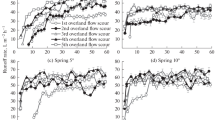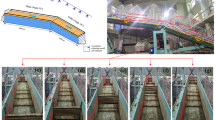Abstract
Downslope wash-scour erosion driven by upslope inflow from compacted platform plays an important role in the acceleration of water and soil loss from engineered landforms. To explore the quantitative effects of variable upslope runoff on downslope runoff and erosion, a typical abandoned spoil deposit derived from the construction of Shenfu Expressway was selected to conduct a set of field runoff scouring experiments on steep slope (72.7 %). Four types of upslope inflow rate patterns including constant inflow rate pattern and earlier, intermediately, as well as later peak inflow rate patterns were designed dependent on different rainfall patterns and the timing for peak inflow rate (total inflow amount was kept constant). Thus, the downslope runoff and erosion response of the selected abandoned spoil deposit under variable upslope inflow conditions were investigated, and the results reveal that: (i) Maximum peak runoff intensity and the timing for the maxima were greatly impacted by upslope inflow rate patterns; however, little impact was exerted on total surface runoff; total runoff from the inflow events with earlier, later, and intermediately peak inflow rate increased by 20.6, 11.7, and 8.5 % in comparison with that from the uniform inflow event. (ii) Runoff events induced by variable inflow rate patterns altered the sediment-yielding process as well as the spatial distribution of sediment yield in the downslope direction, and thus produced more soil loss. Total soil loss from inflow events with earlier, later, and intermediately peak inflow rate increased by 79.7, 78.2, and 14.2 %, respectively, in comparison with that from the uniform inflow event. Statistically, sediment yield from designated control section decreased as a negative exponential function of slope length downslope. (iii) Among the selected runoff erosivity factors, runoff depth, unit runoff erosivity, and stream power are effective indicators for predicting the area-specific sediment yield from individual upslope inflow events, regardless of inflow rate pattern. (iv) Area-specific sediment yield performs remarkable power function correlation with unit runoff erosivity; the unit runoff erosivity can represent the variation in runoff erosion dynamics from individual inflow events, regardless of upslope inflow rate patterns. The results may provide evidence for soil erosion degree assessment, erosion model construction in drastically disturbed areas, as well as the prevention of newly arising water and soil loss from engineered landforms.








Similar content being viewed by others
References
Ahmed SI, Rudra RP, Gharabaghi B, Mackenzie K, Dickinson WT (2012) Within-storm rainfall distribution effect on soil erosion rate. ISRN Soil Sci. doi:10.5402/2012/310927
An J, Zheng FL, Han Y (2014) Effects of rainstorm patterns on runoff and sediment yield processes. Soil Sci 179(6):293–303
Bonta JV (2000) Runoff-energy factors for MUSLE sediment-yield model for surface mines. Int J Sediment Res 15(2):162–181
Bonta JV (2005) Challenges in conducting hydrologic and water quality research in drastically disturbed watersheds. J Soil Water Conserv 60(3):121–133
Dunkerley D (2012) Effects of rainfall intensity fluctuations on infiltration and runoff: rainfall simulation on dryland soils, Fowlers Gap, Australia. Hydrol Process 26(15):2211–2224
Flanagan DC, Foster GR, Moldenhauer WC (1988) Storm pattern effect on infiltration, runoff and erosion. Trans ASAE 31(2):414–420
Foster GR, Lombardi F, Moldenhauer WC (1982) Evaluation of rainfall-runoff erosivity factors for individual storms. Trans ASAE 25(1):124–129
Frauenfeld B, Truman C (2004) Variable rainfall intensity effects on runoff and interrill erosion from two coastal plain ultisols in Georgia. Soil Sci 169(2):143–154
Hancock GR (2009) A catchment scale assessment of increased rainfall and storm intensity on erosion and sediment transport for Northern Australia. Geoderma 152:350–360
Jetten V, de Roo A, Favis-Mortlock D (1999) Evaluation of field-scale and catchment-scale soil erosion models. Catena 37(3):521–541
Jetten V, Govers G, Hessel R (2003) Erosion models: quality of spatial predictions. Hydrol Process 17(5):887–900
Knapen A, Poesen J, Govers G, Gyssels G, Nachtergaele J (2007) Resistance of soils to concentrated flow erosion: a review. Earth Sci Rev 80:75–109
Kumar S, Mishra A (2015) Critical erosion area identification based on hydrological response Unit level for effective sedimentation control in a river basin. Water Resour Manage. doi:10.1007/s11269-014-0909-3
Lei TW, Zhang QW, Zhao J, Tang ZJ (2001) A laboratory study of sediment transport capacity in the dynamic process of rill erosion. Trans ASAE 44(6):1537–1542
Liu Y, Yang W, Yu Z, Lung I, Gharabaghi B (2015) Estimating sediment yield from upland and channel erosion at a watershed scale using SWAT. Water Resour Manage 29:1399–1412
Luk SH, Merz W (1992) Use of the salt tracing technique to determine the velocity of overland flow. Soil Technol 5:289–301
Meyer LD, Wischmeier WH (1969) Mathematical simulation of the process of soil erosion by water. Trans ASAE 12(6):754–758, 762
Nearing MA, Simanton JR, Norton LD, Bulygin SJ, Stone J (1999) Soil erosion by surface water flow on a stony, semiarid hillslope. Earth Surf Proc Land 24:677–686
Parsons AJ, Stone PM (2006) Effects of intra-storm variations in rainfall intensity on interrill runoff and erosion. Catena 67:68–78
Römkens MJM, Helming K, Prasad SN (2002) Soil erosion under different rainfall intensities, surface roughness, and soil water regimes. Catena 46:103–123
Singh VP, Cui H, Byrd A (2014) Sediment graphs based on entropy theory. J Hydrol Eng. doi:10.1061/(ASCE)HE.1943-5584.0001068
Williams J R (1975) Sediment-yield prediction with universal equation using runoff energy factor, pp 244–252. In: Present and pro-spective technology for predicting sediment yield and sources. Pro-ceedings of the sediment-yield workshop, USDA Sedimentation Lab., Oxford, MS, November 28–30, 1972. ARS-S-40
Williams JR (1977) Sediment delivery ratios determined with sediment and runoff models. IAHS Publ 122:168–179
Williams JR, Berndt HD (1977) Sediment yield prediction based on watershed hydrology. Trans ASAE 20(6):1100–1104
Wischmeier WH, Smith DD (1978) Predicting rainfall erosion losses: A guide to conservation planning. USDA Agriculture Handbook No. 537. USDA, Washington
Xiao P, Zheng F, Yao W (2005) Downslope erosion process under upslope runoff and sediment using a dual-box system. Int J Sediment Res 20(2):136–142
Xu JX (1999) Erosion and sediment yield of hyperconcentrated flows on Loess Plateau. Journal of Soil Erosion and Soil and Water Conservation 5(1):28–35 (in Chinese with English abstract)
Yang H, Lin L, He Y (2008) Soil erosion caused by highway construction in expansive soils districts and its prevention measures. In: Geotechnical engineering for disaster mitigation and rehabilitation: proceedings of the 2nd international conference GEDMAR08, Nanjing, pp. 781–789
Zhang G, Luo R, Cao Y, Shen R, Zhang XC (2010) Correction factor to dye-measured flow velocity under varying water and sediment discharges. J Hydrol 389:205–213
Zhang L, Gao Z, Yang S, Li Y, Tian H (2015) Dynamic processes of soil erosion by runoff on engineered landforms derived from expressway construction: A case study of typical steep spoil heap. Catena 128:108–121
Zheng FL (1998) A study on rainfall erosion and runoff erosion. Bull Soil Water Conserv 18(6):20–24 (in Chinese with English abstract)
Acknowledgments
This research was financially supported by the Key Projects in the National Science & Technology Pillar Program during the 12th 5-year Plan Period of China (Grant No. 2011BAD31B01). The gracious assistance from Shaojia Zhang and Kai Wang for field work is also appreciated.
Author information
Authors and Affiliations
Corresponding author
Rights and permissions
About this article
Cite this article
Zhang, L.T., Gao, Z.L., Li, Z.B. et al. Downslope runoff and erosion response of typical engineered landform to variable inflow rate patterns from upslope. Nat Hazards 80, 775–796 (2016). https://doi.org/10.1007/s11069-015-1996-z
Received:
Accepted:
Published:
Issue Date:
DOI: https://doi.org/10.1007/s11069-015-1996-z




